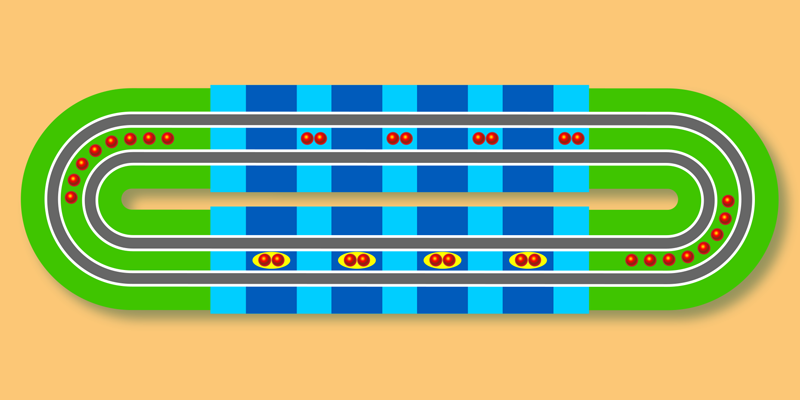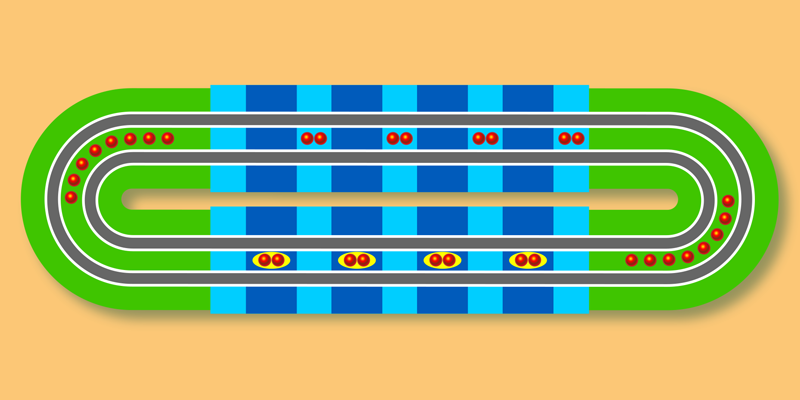Scaling Up a Trapped-Ion Quantum Computer
Scientists are exploring various platforms for future large-scale quantum computation. Among the leading contenders, those in which the quantum bits (qubits) are trapped ions stand out for their low-error operation. However, scaling up such platforms to the millions of qubits needed for utility-scale quantum computing is a daunting task. Now Steven Moses at Quantinuum in Colorado and colleagues describe an impressive new trapped-ion quantum computer, the Quantinuum System Model H2, in which they have been able to increase the number of qubits (from 20 to 32) without increasing the error rate [1]. The researchers have put this system through its paces with full component-level testing, a suite of industry-standard benchmark tests, and a set of diverse applications.
In a typical trapped-ion quantum computer, a linear chain of ions is confined by an electric potential using direct-current (dc) and radio-frequency (rf) fields. Whereas the ion-trap apparatus can be at any temperature, the ions themselves need to be laser cooled to near their ground state. Their motion can then be quantized, and the resulting motional modes can be used to entangle any pair of ions in the chain—a requirement for performing quantum operations. However, controlling individual ions in a long chain comes with its own technical difficulties, and it is unlikely that a million qubits—as needed to build a universal, fault-tolerant quantum computer [2]—could be trapped in a single potential.
In 2002, a group of scientists proposed the so-called quantum charge-coupled device (QCCD) architecture, in which short linear ion chains are connected by physically shuttling ions between storage and interaction regions [3]. A quantum computer based on this architecture comprises many ion traps, each with a set of segmented electrodes. By varying the voltages on these electrodes, single (or groups of) ions can be shuttled around the system to interact with ions in other areas. In this way, the computer can be partitioned into many short linear ion chains, and dynamic ion rearrangement enables arbitrary connectivity.
Since the QCCD architecture was proposed, there has been substantial work toward realizing the dream of a large-scale QCCD trapped-ion quantum computer. Quantinuum scientists previously reported results for one-dimensional geometries [4]. However, putting together all the electrical, optical, and computational building blocks needed to control the ions is nontrivial. Moreover, for true scalability, all this must be done in a way that ensures the per-qubit error rate does not increase as more qubits are added.
Moses and colleagues report a QCCD trapped-ion quantum computer in which the ions move around a racetrack-like structure (Fig. 1). This system integrates and improves upon aspects of previous demonstrations from Quantinuum and other groups and combines three key features. First, rf electrodes are routed under the top surface of the device, leading to increased adaptability for the electrode geometry. Second, a set of dc voltages are applied to multiple electrodes in parallel, reducing the number of individual control voltages that need to be sent into the vacuum chamber housing the device—an important consideration when increasing trap complexity. Third, the ions are loaded into the device from a cloud of cold neutral atoms in a magneto-optical trap (instead of from a warm vapor as is often done), enabling faster ion loading and thereby reducing the time taken to initialize an experiment.
These hardware improvements are bolstered by classical computing infrastructure that allowed Moses and colleagues to perform fully automated calibration of their system and keep track of characterized qubit phases. The researchers also implemented “midcomputation” measurements and real-time feedback—an essential component for future demonstrations of fault tolerance. Although these features had previously been showcased separately by this team and others, their combination forms a formidable device that can operate at the state-of-the-art level.
The engineering work that made this device possible is unquestionably a tour de force. However, it is Moses and colleagues’ thorough characterization that sets their study apart. They began by characterizing each possible component of a quantum algorithm: single-qubit operations, two-qubit operations, state preparation and measurement, and ion transport. With this information, the researchers were able to fully catalog all error sources, finding that the reliability of their system is limited by errors associated with two-qubit operations and with state preparation and measurement.
The researchers did not stop there: they also performed system-level benchmark tests. Although single-operation characterization gives a good first guess of how a machine will perform, full system operation might be worse because of crosstalk, for example. Impressively, the team’s inferred error rates from component-level testing matched well (if not perfectly) those from system-level benchmark tests. One of these benchmarks was quantum volume—an industry standard that characterizes the computational power of a quantum system. The researchers achieved a quantum volume of 216. This value was a record for any machine when the result was first reported, but it was recently beaten by Quantinuum scientists on a different device [5]. Finally, Moses and colleagues put their system through its paces by implementing a set of algorithms, each of which verified a separate capability of the device.
Although Moses and colleagues’ work advances trapped-ion quantum computing and sets a formidable precedent for future efforts, there is still much work to be done before we have utility-scale versions of these devices. First, as the researchers point out, building a truly two-dimensional architecture comes with new challenges—such as achieving low-error ion transport through junctions and scaling up the necessary electrical control signals [6].
Second, Moses and colleagues state that only 1%–2% of the computation time was spent doing quantum operations; the rest was spent shuttling the ions and cooling them. This percentage would be inadequate for a future quantum computer, and substantial effort will have to be made to improve it. One possible way forward is to increase the number of ions in each chain. Although this would increase the technical overhead, it would decrease how many shuttling operations are needed. It will be interesting to see how this balancing act plays out in future work from this team and others.
References
- S. A. Moses et al., “A race-track trapped-ion quantum processor,” Phys. Rev. X 13, 041052 (2023).
- M. E. Beverland et al., “Assessing requirements to scale to practical quantum advantage,” arXiv:2211.07629.
- D. Kielpinski et al., “Architecture for a large-scale ion-trap quantum computer,” Nature 417 (2002).
- J. M. Pino et al., “Demonstration of the trapped-ion quantum CCD computer architecture,” Nature 592 (2021).
- Quantinuum, Quantinuum H-Series quantum computer accelerates through 3 more performance records for quantum volume: 217, 218, and 219, June 30, 2023.
- M. Malinowski et al., “How to wire a 1000-qubit trapped-ion quantum computer,” PRX Quantum 4, 040313 (2023).





